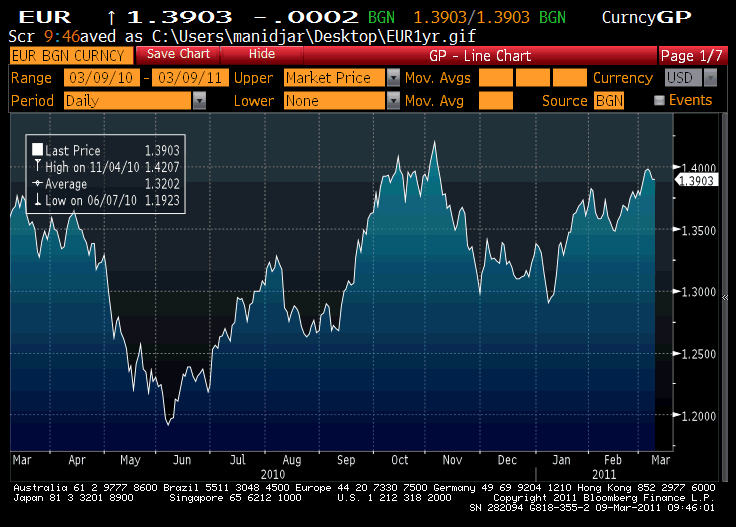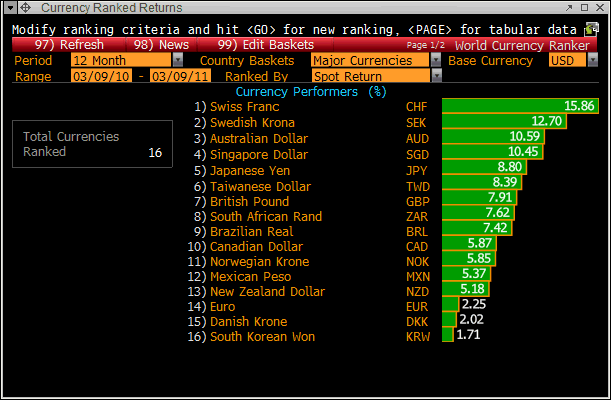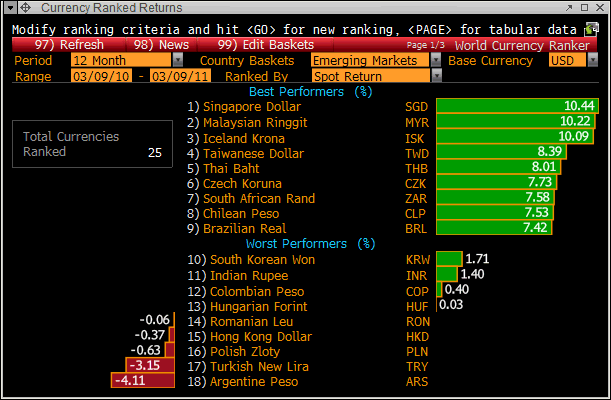Since the Financial Crisis we have highlighted the challenges ahead for G7 countries (fiscal and structural), and the natural result of currency depreciation and rebalancing vis-à-vis the up and coming group of strong currencies. Though the rate of EUR/USD has had sizable swings in the last 12 months, it is not far from where it started (see/click first chart). March is going to be a critical month for Europe, its union and its currency., as multiple senior-level meetings and summit should produce the foundations for the new institutional framework that will determine whether the euro can remain a top currency.
The relative value of USD and EUR is, in simple big picture terms balanced by a couple of pros and cons on each side: the US has a somewhat larger fiscal imbalance and debt ratio, and a monetary authority determined to abuse its currency to attain full employment (and some fiscal adjustment thanks to seignoriage and inflation in the process), but its banking and corporate balance sheets are seen as sound and strong; while on the side of the euro the single mandate to prevent inflation leads to higher interest rates sooner, the institutional flaws of the euro and the uncertainties around its weaker periphery countries prevents a sharper steadier appreciation. Depending on the flavor of the month, these factors push for a weaker dollar one month, and a weaker euro the next. What matters is that during this volatile process, and due to the challenges G7 economies face, their currencies lose value vis-à-vis the other major currencies as well as EM currencies. We believe that such process is bound to continue, albeit a slower pace and with volatility due to government efforts to prevent appreciation.
In the coming weeks Europe is scheduled to produce reforms that could have an impact in the balance between the dollar and the euro. There are relevant meetings planned for March 11, March 14-15 and then March 24-25, in which heads of state, finance ministers, etc., will meet to discuss whether and how to expand the current financial packages as well as a more permanent mechanism to deal with countries that deviate. The usual risk factors that we tend to highlight have and will continue to play: coordination failure is always a risk when so many countries, with their own internal political issues matter, have to negotiate and agree. The obvious and most important example is Germany, where regional elections appear to be denting Ms. Merkel’s power and capacity to be as supportive of efforts to help weaker EU members.
On the ideas around the financial packages, the debate is around expanding the size of the overall fund, allowing it to buy sovereign debt of countries in trouble (allowing the ECB to slow down its balance sheet pollution and mandate deviation), having stronger countries provide debt guarantees to the fund to grow issuing debt, etc. Many of these ideas are likely to survive.
The more troubling debate is on the creation of a more permanent mechanism to address potential imbalances and deviation that through time lead to situations á la Greece and Ireland. France and Germany produced a joint proposal called the ‘Pact of Competitiveness’. Many of its original ideas have already been watered down or faced opposition. But the main idea in it is to grant the EU a more credible authority to monitor and correct country macro developments that lead into such situations (loss of competitiveness, fiscal imbalances, banking sector excesses, etc.). German politics appear to dictate that such a credible mechanism is needed for providing more short-term help. This is a relevant debate to monitor, not only for an exchange rate that through the last 12 months has moved a lot but done little, but for the future of the euro and the stability of the rest of the market.
For more information view our contact info



